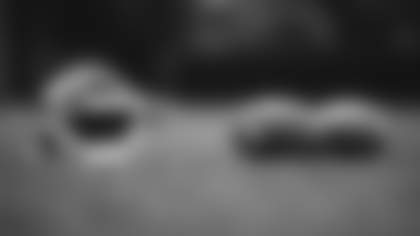
A broken leg was a break for the Jets.
Darrell Austin, a versatile offensive lineman who was drafted by Denver out of the University of South Carolina in 1974, fractured his left fibula during his first training camp. The Broncos then waived him with the intent to bring him back.
Yeah, not so fast.
"I'd only signed a one-year contract," Austin said. "They were wanting to sign me for the following year, but I had to clear injured waivers for them to sign me again, and the Jets claimed me off of the waivers for the '75 season."
And while Austin was in fact heading back to the east coast, New York wasn't like anyplace he'd experienced before.
"Flying in to LaGuardia and making my way to (the Jets' facilities at) Hofstra, for someone from South Carolina, it was kind of intimidating," Austin said with a laugh. "But once I made my way to Hofstra, I was fine."
Austin was also fine with being on the same team as legendary veteran quarterback Joe Namath. Whom he discovered had more of a down-home personality than his reputation would suggest.
"We had a hot therapy pool, and after practice, especially during the training camp, it was kind of nice to get in there and soak, try to recuperate for the next day," Austin said. "And he and I were just sitting there talking about fishing more than anything. He was my hero all through junior high school and high school, and here I ended up centering for him. That was a thrill for me."
After spending his rookie season in a backup role on the line and playing on special teams, Austin earned a spot in the starting lineup in 1976.
"I started out at center and then we had an injury," Austin said. "Winston Hill got hurt and we had to move the right guard, Garry Puetz, to (right) tackle. I think I played three or four games at center and then made the move to guard and Joe Fields took over center. I was kind of used to it because in college I played everywhere and was used to moving around."
Unfortunately for Austin, his teammates, and their fans, beginning in 1975, the Jets had back-to-back-to-back 3-11 seasons and didn't move far from the bottom of the standings. How did he keep a positive attitude during that, let's say, temporary slump?
"Well, Namath and (John) Riggins were there and we were just kind of hoping," Austin said. "I know they had lost a lot of veteran players for retirement and injuries, so we had a fairly young team. We were hoping that they were going to build through the draft. And they did. They brought in Wesley Walker and (Joe) Klecko."
Besides coming up on the short side of the scoreboard during those three seasons, Austin, his teammates, and those same fans, also had to experience no less than five men – Ken Shipp, Charley Winner, Lou Holtz, Mike Holovak, and Walt Michaels – patrol the sideline as their head coach.
"You just kind of shake your head," Austin said. "It's hard to get used to one system and then somebody else comes in and changes it again. But fortunately, we retained the same offensive line coach, Bob Fry, through the whole five coaches. Which was good for us."
In 1979, the Jets traded Austin to the Tampa Bay Buccaneers for an eighth-round pick in that year's Draft.
"Both places were intense. You know, I think the New York fans were in a league of their own as far as following the team, their intensity. It was Jets, Giants, Yankees. I mean, it didn't matter. They were behind them 100 percent," Austin said.
"And I was lucky. My first year in Tampa Bay, we made the playoffs. We were the first playoff team down there and that whole town just went berserk. I remember going to work right after we won the last game of the season to make the playoffs, and there were probably 25,000 people lined up at the stadium trying to get tickets for the next week's playoff game."
It was while Austin was playing for Tampa Bay when he began to take steps towards a second career.
"I got into physical therapy," Austin said. "The trainer for the Buccaneers, Tom Oxley, was a physical therapist. I was already past the 30-year-old mark and was looking for something to do (after football). Back in those days, the coaches, they weren't making anything much. Plus, you had to move constantly if you don't move up the ladder. And I said, 'I don't want to do that.' I started talking with him and said, 'Well, it's one way I can stay around athletes.'
"They had a community college there in Tampa, and after practice, I took night classes and got into PT school. I got my degree and then he and I opened up sports medicine clinics around Tampa.
"I ended up helping the Buccaneers on game day with injuries. I'd be the one to go out on the field and load them up on the little cart and take them to get x-rayed or whatever. And then I'd help them with their rehab. If any of them had surgery, they'd send them to me and I'd get them ready to go back to where the trainers can take over."
Leaving Tampa after selling their Austin & Oxley Rehab Clinics, Austin returned to South Carolina and eventually to his hometown of Union, where he opened his own office, Austin Rehab.
He and his wife, Kelly, now make their home in Prosperity, SC, where the father of four: Grayson, Olivia, Chase, and Cade; and grandfather of four, is semi-retired.
"I'm working with a friend of mine," Austin said. "I sold my business and retired, but decided I wasn't ready to retire. I still wanted to work. He was needing some help, so I'm helping him."














